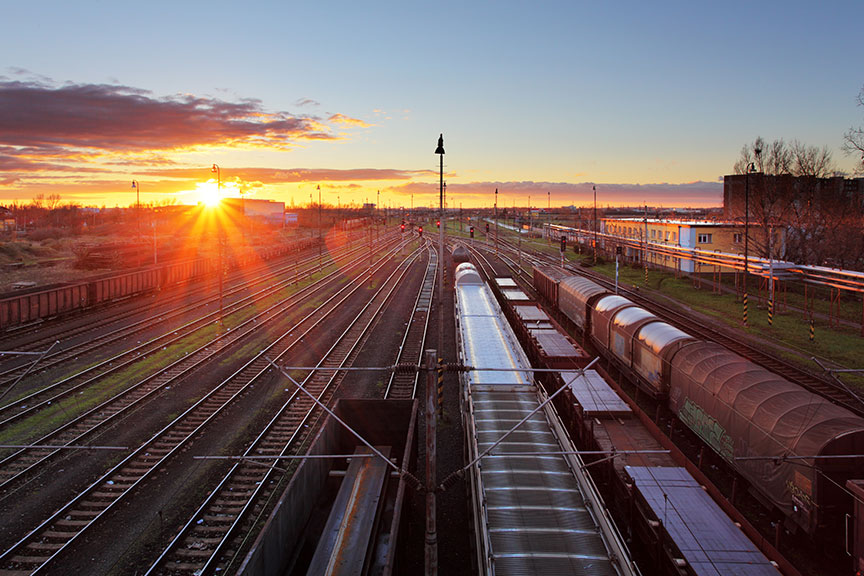Many businesses understand the significant cost benefits that come with choosing railroad shipping. In 2020, RSI Logistics compared the cost difference for shipping products from Cleveland, OH to Houston, TX between the trucking and rail systems. Taking in a railroad cart’s ability to carry four times more than a single truck load, RSI determined the railcar cost equivalent as just $1,669 compared to the truck cost, which totaled $20,636.
So, why do most businesses still choose trucking over railroads?
The answer lies in rail switch maintenance safety.
If railroads make the news, it almost always surrounds another dangerous train derailment. The latest instance to make international news occurred back in February when a train, carrying toxic chemicals, derailed because of an overheated wheel bearing in East Palestine, Ohio. The derailment opened up a greater conversation in America spanning from big government conspiracy, concerns for the environment, and above all, a call for better safety for rails, whether through a higher frequency of heat detectors or even basic rail switch maintenance.
When these disasters occur, the responsibility then falls on the railroad operators to not only fix the problem, but guarantee it won’t happen again. In the case of East Palestine, Norfolk Southern’s failure to recognize the heating bearing led many to conclude that the operator’s safety procedures were insufficient for operation in the first place.
Across the 30-mile stretch, Norfolk Southern had three detectors strategically placed to monitor issues like overheated wheel bearings or other important logistics pertaining to rail switch maintenance. Yet even after the second detector, the rail cart remained under Norfolk Southern’s 170-degrees Fahrenheit action threshold outlined in their safety policies. It was between the 19-mile gap between the second and third detector that the train showed fast-paced signs of distress — but it was already too late.
Even though East Palestine resulted from overheated bearings, derailments can boil down to things as basic as regular rail switch maintenance.
The broad range of issues posed in the rail conversation places operators like Norfolk Southern, CSX, and BNSF Railway under massive scrutiny for their safety practices. The incident has inspired federal authorities to consider adding regulations for the railroad industry. So, while authorities highlighted the crew’s ability to act in accordance with safety protocols, regulators have still used the derailment as an excuse to implement more costly regulations that may take years to actualize.
As a combination between frightening derailments and looming regulatory action, those responsible for train and rail switch maintenance have experienced a significant decline in productivity. In a report from Bank of America, they cited a 6.2% decline in rail traffic in comparing a six-week period from this year with the same timeframe’s activity a year prior. Similarly, the report acknowledged only a 10.5% average quarter four revenue between six leading operators, many of whom trended under the average.
Though the mainstream demonizes operators, many still strive for safety, despite the logistical challenges it poses.
Just like the spacing between hot-box detectors, unmaintained rail switches have the potential to create minor to major train derailments without the proper care. Looking at the situation in terms of rail switch maintenance, there are about 7,500 rail yards in the United States. Each yard then has around 50 rail switches per yard, meaning there are upwards of 375,000-400,000 rail switches throughout the country.
So, while many outsiders are quick to blame operators for negligence, the sheer volume of switches poses a huge logistical challenge for operators. Nonetheless, they still work tirelessly to attend to their rail switch maintenance. One method for preserving rail switches is multi-purpose oil lubricants, which leaves a liquid finish prone to gunking. Graphite lubricant though is perhaps the most popular solution when it comes to treating rail switches. Compared to multi-purpose oil, graphite lubricants have a moistureless finish, but its powder form makes full application difficult. As operators apply more layers, the same effect as the multipurpose oils begins with the same excessive residue build-up, which decreases operational safety.
Glidex: The Solution to Rail Switch Maintenance
While these solutions like graphite and multipurpose oil fail to create long term solutions, Midwest’s Glidex rail switch lubricant provides long-lasting service and easy application to deliver an effective product, and to give operators and their customers the necessary assurance for a safe operation.
Unlike an oil or powder, Midwest applies Glidex as a liquid, lubricating every nook and cranny to form the needed barrier between the tracks and train as part of basic rail switch maintenance. Glidex outperforms these other fixes with added lasting benefits.
Glidex products can withstand a broad range of harsh weather conditions, from extreme temperatures to turbulent downpours and snowstorms. For more information regarding its weather resistance, you can check out our article What is Winter Costing Your Railroad? Matched by Glidex’s insoluble chemical makeup, you can trust this step in your rail switch maintenance will surpass a regular wear and tear timeline.
Implementing Glidex also carries the benefit of avoiding delays. Without an all-encompassing rail switch maintenance solution like Glidex, your operation runs a greater risk of not only experiencing delays, but experiencing accidents as a result. The smooth operation of reduced metal-on-metal friction can increase the lifespan of your rail switches. The increased lifespan alongside Glidex’s long-term effectiveness can reduce your operation’s maintenance costs.
Moreso than these efficiency and practicality, Glidex delivers the most important component to rail switch maintenance: safety. At Midwest, we craft products geared toward safety first. The benefits of reduced costs, operational longevity, and switch health, are mere additions to Glidex’s central purpose, which is guaranteeing safe rail switch operation. In a time where faith in rail appears at an all-time low, Midwest products like Glidex seek to re-instill confidence in rails as an inexpensive, effective, and most importantly, safe mode for shipping and transportation.
For more information on Glidex and Midwest’s other railway products, contact us.

